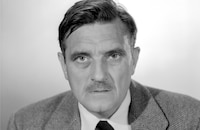North of the Rio Grande
Brief Synopsis
Cast & Crew
Nate Watt
William Boyd
George Hayes
Russell Haydon
Stephen Morris
Bernadene Hayes
Film Details
Technical Specs

Synopsis
When Hopalong Cassidy's friend, Lucky Jenkins, reports that Hoppy's brother Buddy has been killed by a bandit called the Lone Wolf, Hoppy goes to Cottonwood Gulch pretending to be outlaw Wild Bill Dynamite Magroo to get revenge. Saloon girl Faro Annie, who works for Crowder, Lone Wolf's assistant, befriends Hoppy against Crowder's orders. His first night in town, Hoppy holds up a coach to get Lone Wolf's attention. Crowder warns Hoppy not to intrude on his territory and orders crooked deputy sheriff Jim Plunkett to follow Hoppy to locate his booty. Hoppy visits Buddy's widow Mary at the Bar Q ranch, and when Plunkett tries to shoot Hoppy, he shoots Plunkett dead. Railroad president Goodwin then asks Crowder to find Hoppy, whom he believes is the only man who can bring down Lone Wolf. A masked Lone Wolf, who Hoppy notices wears an ornate ring, meets "Magroo" and hires him to steal a large gold shipment that is coming through town the next day. Hoppy then visits Goodwin, reveals his true identity and returns the gold he stole his first night in town. Goodwin tells Hoppy to get instructions for capturing Lone Wolf from Henry Stoneham, who runs the town's bank and general store. Hoppy visits Stoneham and, noticing his ring, exposes him as Lone Wolf. Lone Wolf ties Hoppy to a chair and collects his and Crowder's money to skip town. While Lucky waits for Hoppy to arrive so they can capture the gang, Lone Wolf forces Windy Holliday to engineer the train out of town with him on board. Crowder races to stop Lone Wolf, with Lucky and his men following. Annie then sees Hoppy's horse tied up outside Stoneham's office and rescues him. Crowder and Lucky's men converge near the train tracks, and Hoppy's men apprehend the gang, but Lucky is shot in the shoulder and gets his foot caught in the tracks. Hoppy switches the train to a track that ends at a cliff and saves Lucky, but Windy is feared dead, until Hoppy and Lucky find he has jumped the train and landed in a cactus patch. All three friends say goodbye to Annie, who is once again left alone.

Director
Nate Watt
Cast

William Boyd

George Hayes
Russell Haydon

Stephen Morris
Bernadene Hayes
John Rutherford
Lorraine Randall
Walter Long

Lee Cobb
Al Ferguson
John Beach
Crew
D. M. Abrahams
Henry Donovan
Russell Harlan
George A. Hirliman
Al Kennedy
Harry Knight
Jack O'donnell
Lewis Rachmil
Earl Sitar
U. O. Smith
Robert Warwick
Adolph Zukor

Film Details
Technical Specs

Quotes
Trivia
Notes
The title card for this film reads: "Clarence E. Mulford's North of the Rio Grande." A pre-production news item in Hollywood Reporter on March 17, 1937 stated that the exteriors for the film would be shot in Sonora, CA beginning March 22, 1937, and interiors would be done at General Service Studios. Shooting was delayed until 5 Apr, however, at which time Hollywood Reporter announced that interior shooting would take place at Grand National Pictures' studios. Although the viewed print listed George Hirliman above the title as presenter, copyright records state that the film was presented by Adolph Zukor. Hollywood Reporter also states that because there were three actors with the last name of "Hayes" in the cast, producer Harry Sherman had decided to changed Lorraine Hayes's name to Lorraine Randall. Bernadene Hayes was Lorraine's sister. Although Lewis Rachmil's name is usually spelled with an "a," this film's credits spell it "Rochmil." In addition, actor Russell Hayden's surname is spelled "Haydon," and the film lists George Hayes's character as "Windy Holliday," although he is called "Windy Halliday" in the remainder of the Hopalong Cassidy series. According to files in the MPAA/PCA Collection at the AMPAS Library, this film was initially rejected by the Hays Office because of the killing and injuring of children during the outlaws' battle in the schoolyard, and because of "unnecessary and offensive drinking throughout." This was apparently the first film of actor Lee Cobb, who, under the name Lee J. Cobb became a distinguished Broadway, motion picture and television actor. Modern sources list the following additional cast members: Lafe McKee, Bill Nestell, Fred Burns, Lee Brooks, Dick Cramer, Harry Bernard, Buck Morgan, Herman Hack, Horace B. Carpenter, Carl Mathews, George Morrell, Charles Murphy, Cliff Parkinson, Al Haskell, Leo McMahon, William O'Brien, Hank Bell, Ted Billings and Cliff Lyons. This film was re-released in 1946. It was the fifth film in Paramount's Hopalong Cassidy Series. For more information on the series, consult the Series Index and see the entry for Hop-Along Cassidy above.












